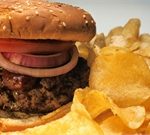
Rushed for lunch? Yes, that nearby fast-food chain is convenient, but by tweaking your choices you can cut unwanted salt, fat and calories. When the U.S. Department of Agriculture (USDA) updates its food guidelines, it doesn’t exactly break down how you’re supposed to fit all the healthy parts of the food pyramid into your lunch. To make it easier to make healthy choices, the Choose My Plate initiative crafted a campaign that suggests small changes that take little effort, but ones that will rev up the nutrition quotient for your midday meal. These can be as simple as switching out one item for another. Think vinaigrette instead of creamy salad dressings, and grilled proteins instead of those fried chicken tenders. If two slices of pizza with pepperoni are your favorite go-to option, replace one slice with a side salad and have the other topped with vegetables. You can apply these same principles when you pack a brown-bag lunch. Modifying perennial lunchtime favorites just a speck can make a real difference in nutrients without sacrificing taste. For instance, instead of peanut butter and jelly with a small bag of chips, switch to peanut butter and banana and add baby carrots for some crunch. You’ll cut calories by about 45% and slice saturated fat in half. Love chicken salad? Next time it’s on your menu, cut the… read on >



























-300x200.jpg)










